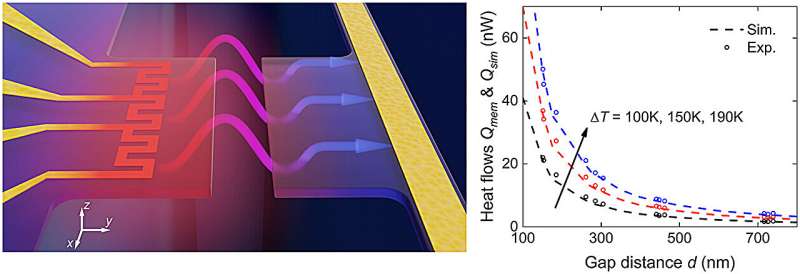This article has been reviewed according to Science X's editorial process and policies. Editors have highlighted the following attributes while ensuring the content's credibility:
fact-checked
trusted source
proofread
Eyes on the impossible: First near-field, subwavelength thermal radiation measurement

Nanodevices change the way we diagnose disease, process food and water, and store renewable energy. But to keep up with next-generation technology, researchers need to understand the fundamental principles that prompt their functionality.
In physics, Planck's Law describes how much heat can be transferred between two objects when the size of the gap between the objects is larger than the thermal wavelength, which is about 10 micrometers at room temperature. Past research by Sheng Shen, Professor of Mechanical Engineering, found that Planck's Law can be broken at the nanoscale—when objects are closer together, energy emission exceeds expectations.
Now, after years of trial and error, Shen's lab has fabricated an advanced instrument to collect the first nanodevice-enabled near-field thermal measurement. Their findings reveal entirely new insight into energy transport physics within nanodevices—a cornerstone towards nanodevice applications for energy conversion and harvesting.
"We wanted to push the limit," said Sheng Shen, Professor of Mechanical Engineering. "Can we make both the gap AND the object smaller to better understand heat transfer at the nanoscale?"
To explore this, Xiao Luo, Ph.D. Candidate in Mechanical Engineering, custom-built a novel nanodevice platform with suspended heating thermometry to report the first measurement of near-field thermal radiation between two sub-wavelength structures.
"I overcame a lot of fabrication difficulties including contamination, broken devices, and membranes getting stuck together," said Luo. "The whole idea is for two tiny membranes to be perfectly aligned with one another without interference from any other object that could also transfer heat."
Luo used chemical etching to suspend the two membranes, one with a long beam sensor to monitor heat absorption, by removing most of the substrate. He then measured the thermal radiation between the devices at a variety of gap distances ranging from roughly 150 nm to 750 nm.
Compared to theoretical blackbody radiation, the team demonstrated a 20-fold enhancement in heat transfer between two subwavelength surfaces with a separation gap of 150 nm.
"The surprising thing is that the whole story doesn't revolve around the gap size like we previously thought," said Shen. "When we made the object smaller than the wavelength, thermal radiation wasn't enhanced nearly as much as expected based on the theory for two large objects. Researchers must analyze both the structure and the underlying physics to understand this phenomenon."
Luo and team validated their findings using a computational simulation.
Shen believes that it will be another 10 to 20 years before consumers see a tangible product developed with this foundational physics in mind, but is confident in its value to thermal engineering and photonics.
The work is published in the journal Nano Letters.
More information: Xiao Luo et al, Observation of Near-Field Thermal Radiation between Coplanar Nanodevices with Subwavelength Dimensions, Nano Letters (2024). DOI: 10.1021/acs.nanolett.3c03748




















